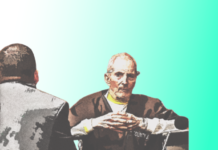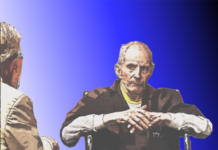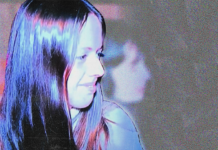You can read all of Charles V. Bagli’s previous reporting for Crime Story here.
You can find links to all of Crime Story’s coverage of the Robert Durst trial here.
Kathie A. McCormack saw him across the room. A year out of high school in 1971, she had traded a quiet life in the Long Island suburbs for a walk-up apartment in Manhattan and a job that barely covered her bills. But meeting people whose life was so different from her own was part of what made living in the city so exciting for Kathie.
Slender, blonde and blue-eyed, Kathie quickly learned that his name was Robert Durst. The guy was older, handsome and only a couple inches taller than she was. He had longish hair,spoke with an air of authority, and had a cutting sense of humor. There was a small crowd in his one-bedroom apartment in a narrow four-story building on the Upper East Side, with a rare, little garden in back.
On that pretty Sunday afternoon in the fall, the attraction between Kathie and Robert was immediate and mutual. “He was talking about accounting and all this other stuff, which didn’t interest me one iota,” recalled Cheryl Catranbone, Kathie’s roommate at the time and a friend from New Hyde Park Memorial High School. “But you could see she was smitten, and so was he.”
“When they met,” Catranbone told me, “the stars collided.”
That was the start of what Kathie’s brother Jim McCormack called a storybook romance. Durst was a scion of a major New York real estate family whose buildings were an enduring part of the city’s skyline; his father was pictured in a New York magazine article, “The Men Who Own New York.”
Kathie was the youngest of five siblings from a close-knit, lower middle-class family where money was tight.
A decade later the couple was married, splitting their time between a West Side Manhattan penthouse, an East Side apartment, and a stone bungalow in the New York State countryside… and their fairytale relationship had descended into a horror show of bickering, break-ups, shoving, affairs and, ultimately, outright violence.
On January, 31, 1982, Kathie, then 29, suddenly vanished, just a few months shy of achieving her lifelong goal of graduating from medical school and becoming a doctor. There were no last calls to her many friends, and no note to her mother Ann McCormack, who died in 2015 at 102 still wondering what had become of her youngest daughter. Kathie was just gone.
Kathie’s disappearance has been an enduring mystery for nearly 40 years, prompting books, a podcast series, a movie, a documentary and several TV news magazine stories, and multiple criminal investigations. Plenty of suspicion, but no body, no official crime scene, and no charges.
Now, four decades later, the mystery of what happened to Kathie may be nearing a resolution. Robert A. Durst, 78, who was Kathie’s husband at the time of her disappearance, is on trial for murder in Los Angeles. He stands accused of shooting a confidante, Susan Berman, in the back of the head in Benedict Canyon, just before Christmas Day 2000. The prosecutors, headed by Deputy District Attorney John Lewin, argue that Berman was both a victim of Durst and an accomplice.
Prosecutors contend that what happened in Los Angeles in 2000 tracks back 18 years to New York and Kathie’s disappearance. Berman, they say, helped Durst cover up his murder of Kathie. Afraid that Berman was about to spill the beans to investigators who had reopened the case in 2000, prosecutors further allege, Durst killed Berman too.
Durst pleaded not guilty, saying he did not kill Susan Berman and does not know who did. His lawyers say that Kathie’s disappearance is as much a mystery to him as to her family and friends. In the courtroom, his defense team has painted Kathie as a cocaine-addled gold digger who was on the verge of flunking out of Albert Einstein Medical School. That closely mirrors how both Durst and Berman described the missing Kathie to police in 1982.
A far different picture of Kathie has emerged from my 20 years of interviewing her family members, friends, lovers and classmates, reviewing her academic records, and from the testimony of her med school supervisors. No one disputes that Robert and Kathie Durst enjoyed the recreational drugs that flowed in certain social circles and through Studio 54, Xenon and other nightclubs of the era. But, her friends and family say, Kathie was intensely focused on becoming a doctor.
“She was excited to be a medical student,” her former classmate,” Dr. Alicia Landman-Reiner, told me. “She worked very hard. She always took a seat in the front row and took notes.”
“She was only three months shy from becoming a doctor and she never would have given that up,” Jim McCormack said in 2001. “She knew she wanted to be a healer. She loved helping people.”
Kathie — the person on the verge of becoming a doctor when she vanished — is sometimes lost in the tumult of the Robert Durst story and the span of time. But as Los Angeles Deputy District Attorney John Lewin has told the jury, this mind-bending tale really begins with Kathie. Her family, which has struggled for decades to discover what happened — and maybe even Robert Durst himself — would agree.
Kathie McCormack, like Robert Durst, lost a parent at a young age. Kathie’s dad died of cancer when she was a teenager. More on that experience in a moment. Durst’s mother either fell or jumped from the roof of their home when Bob was only seven, leaving a psychic scar that never healed.
They both grew up in the suburbs of New York City. But they were worlds apart. Home for Durst, scion of a prominent real estate family, was in Scarsdale, one of the wealthiest towns in America, while the McCormacks nestled in New Hyde Park on Long Island, a modest commuter town of about 10,000.
Kathie’s parents, James and Ann, had made the pilgrimage with their family from Brooklyn to Queens before jumping to the suburbs in 1962, even if it was only eight miles from the border with New York City. New Hyde Park, largely white and Asian with a handful of African Americans, offered affordable houses, safe streets, and a solid high school. “We felt like we were living in the country,” Kathie’s older brother, James, recalled.
Kathie’s father, a World War II vet, was an account representative for the telephone company, a job that took him from military bases to Aqueduct Racetrack to Mary Immaculate Hospital. Her mother raised the family. The youngest of five children Kathie was doted on by both her parents and her siblings, Carol, James, Virginia and Mary.
The family was close. They gathered for Sunday dinners of pot roast and mashed potatoes, with the children divvying up responsibility for washing the dishes, drying them, and putting them away. James was religious and the Catholic Church loomed large in family life and education. Ann McCormack gave up her Lutheran upbringing when she married James.
Their lives changed in 1966, when Kathie’s father was diagnosed with colon cancer. His illness planted a seed in Kathie, who helped care for her father, that would not sprout until after she met Durst. Her father died at 56 the following year, when Kathie was 14. Anne eventually went to work at the phone company to make ends meet. Kathie had part-time jobs to help out. “She was a worker,” her sister Mary said. “We all were.”
Even so, Kathie did well at New Hyde Park Memorial High School, earning good grades, becoming a member of the National Honor Society and dating the captain of the football team. James, who was always Jim to Kathie, became a surrogate father to her, as he drove her to modeling jobs at Roosevelt Field, the largest shopping mall on Long Island.
“She was always very open, happy, confident and accomplished,” recalled Cheryl Catranbone, Kathie’s high school classmate and later big city roommate. “I could watch her sit down with Vogue magazine, admiring a dress. She’d walk out, buy the material and make it. No pattern. She was also an amazing cook.”
Cheryl and Kathie became fast friends when they worked for a dentist, a relative of Catranbone. After high school graduation, Kathie tried to figure out her next steps. When Cheryl, a year younger, finished high school in 1971, the two decided to move to the “city,” meaning the intoxicating and dangerous streets of Manhattan. Kathie got a job as a dental assistant to a dentist in the famed Plaza Hotel, while occasionally picking up extra money working at Saks Fifth Avenue. Cheryl worked for a dentist in Rockefeller Plaza.
After paying the rent, they did not have a lot of money to spare. A big Saturday night out, Catranbone recalled, was walking to Brasserie, a restaurant in the Seagram Building at Park Avenue and 53rd Street, and ordering a bowl of onion soup. But they were on their own, outside the suburban nest. “We were free and independent,” said Catranbone.
On a Sunday afternoon in the fall of 1971, Catranbone bumped into a neighbor, Stewart Altman, who lived one floor up from her at 253 E. 52nd St. and Second Avenue. She accepted his invitation to a get-together at the Manhattan apartment of his lifelong friend, Robert Durst, who was then primarily living in Vermont. She left a note asking Kathie to join them, which she did. Kathie, then 19, was drawn to Durst, who was 28 and back on the East Coast after attending graduate school at UCLA.
“It was a mutual attraction, a chemistry,” Mary McCormack Hughes, Kathie’s sister, said in an interview. “She told me she loved him; he loved her. She didn’t know about the money” at first. “He was very handsome. He had a magnetism. Kathie had the same thing.”
Their romance moved very quickly. After two dates, Bob asked her to join him in Middlebury, VT, a small college town where he had bought a health food store called All Good Things. She moved to Vermont in January 1972, gradually taking on more and more responsibility for running the store. Showing up on time and sticking to a schedule were not Bob’s strong suit. He had already developed a lifelong habit of getting high on pot every day.
Bob and Kathie, as well as their friends, referred to it as their back-to-the-land, hippie life. “He was like Prince Charming and she was like Cinderella in the very beginning,” Jim McCormack recalled.
By the end of the year, however, Bob was ready to move on. He sold the store. From Vermont, the couple headed to Katonah, a wooded countryside community north of New York City where Bob’s father Seymour had bought a mansion to use as a family gathering place. Later, Bob’s brother Douglas and his family moved into the mansion, creating a fraught living arrangement as the two brothers had never gotten along. Meanwhile, Seymour was hoping his eldest son Bob would join him at the Durst Organization, the family real estate business, which included land and buildings in Times Square and on the East Side of Manhattan, now worth an estimated $8 billion.
But Bob was not ready to do that. The couple spent March of 1973 driving through the South. When they returned to New York, Kathie brought up the idea of marriage.
They exchanged rings on Bob’s birthday, April 12, 1973, at a ceremony in nearby Bedford, NY, where the only attendees were Kathie’s mother, Ann, and Bob’s father Seymour. Kathie had agreed, at Bob’s insistence, that they would not have a fancy wedding reception. Ann paid the tab for the dinner that followed the ceremony. Afterwards, the couple piled into a van for a six-month long cross-country tour of America, camping and staying in motels.
During the trip, Bob confessed that his claim to have gotten a PhD in economics at UCLA was a lie. He had withdrawn from school in 1969 without completing the work. He asked her not to tell his family.





